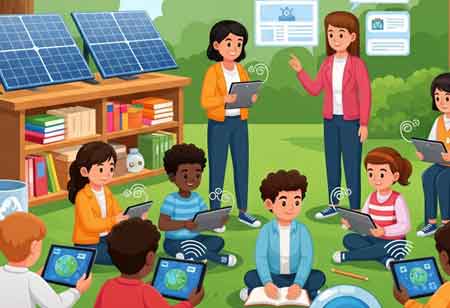THANK YOU FOR SUBSCRIBING
Be first to read the latest tech news, Industry Leader's Insights, and CIO interviews of medium and large enterprises exclusively from Education Technology Insights
Distance Learning Shaping the Future of Education

By
Education Technology Insights | Wednesday, August 27, 2025
Stay ahead of the industry with exclusive feature stories on the top companies, expert insights and the latest news delivered straight to your inbox. Subscribe today.
FREMONT, CA: The introduction of video conferencing tools has enabled real-time, interactive learning experiences that closely mirror traditional classroom settings. At the same time, learning management systems offer reliable platforms for course delivery, assessments, and student engagement. These innovations are especially valuable for non-traditional learners, such as working professionals, parents, and individuals in remote areas, by providing greater flexibility and improved access to quality education.
The ability to balance education with other responsibilities has made remote learning an attractive option, increasing enrollment in online programs. It provides opportunities for individuals in remote or underserved areas to access quality education that might otherwise be unavailable. The cost benefits of distance and remote learning are significant. For institutions, it reduces the need for physical infrastructure and associated expenses, such as maintenance and utilities. The scalability of online programs allows institutions to reach a larger audience without proportionate increases in cost, contributing to the overall economic efficiency of distance learning models.
Distance and remote learning have a global reach, enabling institutions to attract diverse students from different geographical and cultural backgrounds. For students, it eliminates costs related to commuting, accommodation, and physical textbooks, making education more affordable. The diversity enriches the learning experience, fostering cross-cultural understanding and collaboration. Institutions can offer specialized programs and courses that cater to niche markets and interests, which may not be viable in a traditional setting due to limited local demand. The global nature of online education also facilitates international collaborations and partnerships, enhancing the quality and scope of educational offerings.
With physical campuses closed, institutions had to transition to online delivery to ensure rapid continuity of education. The shift highlighted the importance of flexible learning models and accelerated the integration of digital tools in education. Even post-pandemic, the experience has led to a lasting change in attitudes towards remote learning, with many institutions and students recognizing its value and continuing to embrace it as a viable alternative or supplement to traditional education. The growth of distance and remote learning has spurred innovation in pedagogical approaches. Online education leverages multimedia content, interactive simulations, and gamification to enhance engagement and learning outcomes.
Adaptive learning technologies personalize the learning experience, catering to individual student needs and learning styles. Data analytics provides insights into student performance, enabling educators to tailor instruction and support to improve retention and success rates. The innovations are transforming the educational landscape, making learning more effective and enjoyable. The rise of distance and remote learning is more comprehensive than traditional education sectors. Corporate and professional training programs have embraced online learning to upskill and reskill their workforce.







